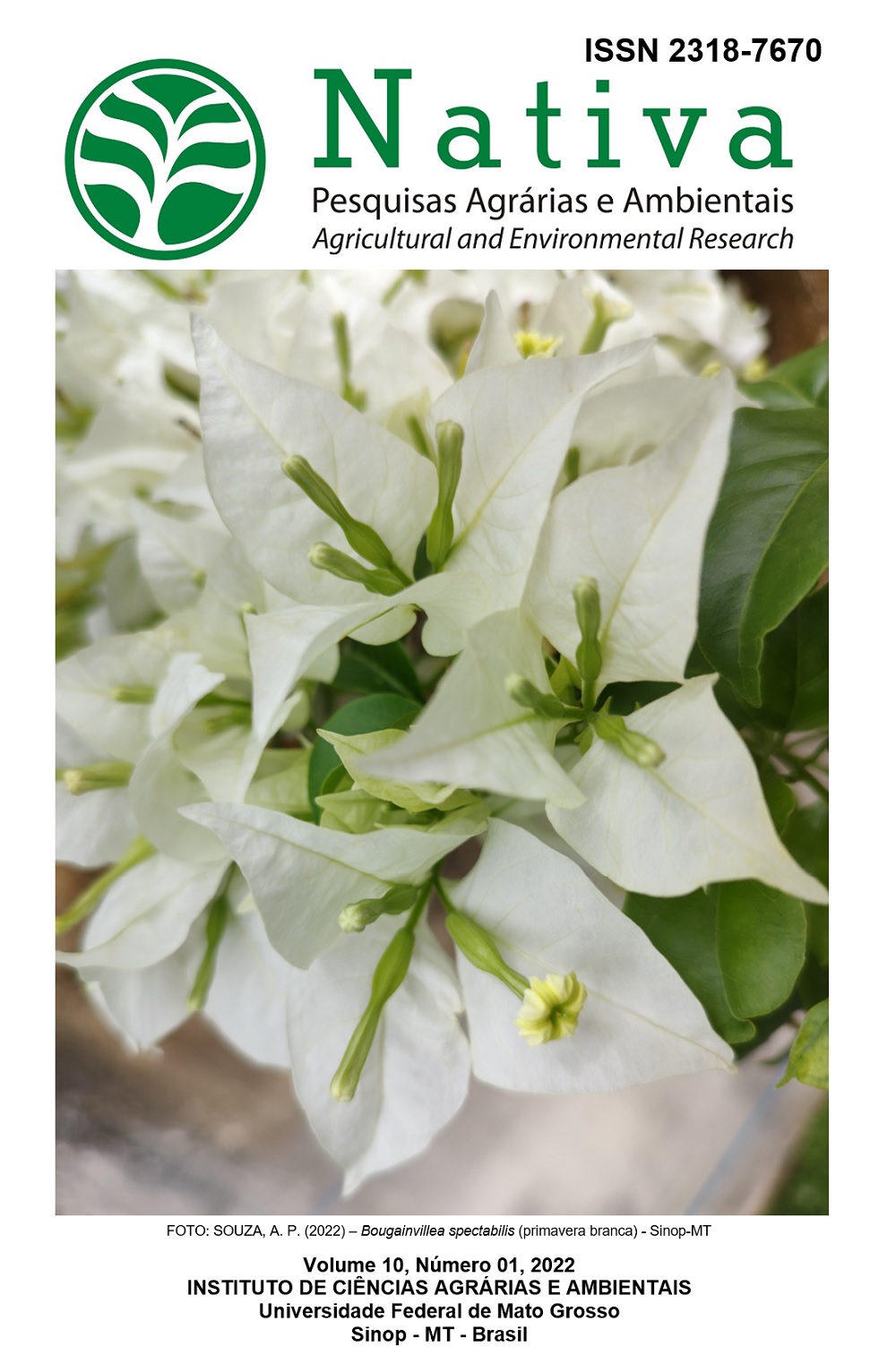REDUÇÃO DE FUNGOS E QUALIDADE FISIOLÓGICA DE SEMENTES DE MILHO INOCULADAS COM Trichoderma harzianum
DOI:
10.31413/nativa.v10i1.13011Keywords:
Controle biológico, Milho, Patologia de sementesAbstract
Corn (Zea mays L.) is affected by a multitude of diseases, causing great damage and losses in production. Thus, seed treatment is essential to ensure good productivity with higher yields. The objective of the research was to evaluate the effect of Trichoderma harzianum on the sanitary and physiological quality of corn seeds. Maize seeds, originating from the municipalities of Sumé (lot 1), Monteiro (lot 2) and Prata (lot 3) were subjected to ten treatments, consisting of T1 = control (no treatment), T2 = dicarboximide fungicide (24 g. kg-1 of seeds), T3 = 0.50; T4 = 1; T5 = 1.5; T6 = 2; T7 = 2.5; T8 = 3; T9 = 3.5 and T10 = 4 g of T. harzianum. kg-1 of seeds. The seed health test (Blotter test) was carried out in order to evaluate the presence of pathogens and the physiological aspects were determined by seed germination and vigor. The use of T. harzianum, regardless of the concentration applied to corn seeds, was effective in reducing Aspergillus sp.; A. niger; Penicillium sp. and Fusarium sp. T. harzianum did not negatively affect the physiological quality of seeds and provided an increase in germination percentages.
References
AGROFIT. Sistema de Agrotóxicos Fitossanitários. Disponível em: http://agrofit.agricultura.gov.br/agrofit_cons/principal_agrofit_cons. Acesso em: 08 abr. 2017.
ANTONELLO, L. M.; MUNIZ, M. F. B.; BRAND, S. C.; RODRIUES, J.; MENEZES, N. L.; KULCZYNSKI, S. M. Influência do tipo de embalagem na qualidade fisiológica de sementes de milho crioulo. Revista Brasileira de Sementes, v. 31, n. 4, p. 75-86, 2014. DOI: https://doi.org/10.1590/S0101-31222009000400009
ALTOMARE, C.; NORVELL, W. A.; BJÖRKMAN, T. E HARMAN, G. E. Solubilization of phosphates and micronutrients by the plant-growth-promoting and biocontrol fungus Trichoderma harzianum. Applied and Environmental Microbiology, v. 65, n. 7, p. 2926-2933, 1999.
BRASIL. Ministério da Agricultura, Pecuária e Abastecimento. Regras para análise de sementes. Secretaria de Defesa Agropecuária. Brasília: MAPA/ACS, 2009. 399p.
CARVALHO, D. D. C.; MELO, S. C. M.; LOBO JÚNIOR, M.; SILVA, M. C. Controle de Fusarium oxysporum f. sp. phaseoli in vitro e em sementes, e promoção do crescimento inicial do feijoeiro comum por Trichoderma harzianum. Tropical Plant Pathology, v. 36, n. 1, p. 28- 34, 2011. DOI: https://doi.org/10.1590/S1982-56762011000100004
CATÃO, H. C. R. M.; MAGALHÃES, H. M.; SALES, N. L. P.; BRANDÃO JÚNIOR. D. S.; ROCHA, F. S. Incidência e viabilidade de sementes crioulas de milho naturalmente infestadas com fungos em pré e pós-armazenamento. Ciência Rural, v. 43, n. 5, p. 764-770, 2017. DOI: https://doi.org/10.1590/S0103-84782013000500002
CRUZ, J. M. F. D. L.; MEDEIROS, E. C. D.; FARIAS, O. R. D.; SILVA, E. C. D.; NASCIMENTO, L. C. D. Microbiolization of organic cotton seeds with cerevisiae Trichoderma sp. and Saccharomyces cerevisiae. Journal of Seed Science, v. 42, e202042021, 2020. DOI: https://doi.org/10.1590/2317-1545v42229182
LÓPEZ-BUCIO, J.; PELAGIO-FLORES, R.; HERRERA-ESTRELLA, A. Trichoderma as biostimulant: exploiting the multilevel properties of a plant beneficial fungus. Scientia Horticulturae, v. 196, p. 109-123, 2015. DOI: https://doi.org/10.1016/j.scienta.2015.08.043
LUZ, W. C. Efeito de bioprotetores em patógenos de sementes e na emergência e rendimento de grãos de milho. Fitopatologia Brasileira, v. 26, n. 1, p. 16-20, 2001.
MACHADO, D. F. M.; PARZIANELLO, F. R.; SILVA, A. C. F.; ANTONIOLLI, Z. I. Trichoderma no Brasil: o fungo e o bioagente. Revista de Ciências Agrárias, v. 35, n. 1, p. 274-288, 2012. DOI: https://doi.org/10.19084/rca.16182
MAGUIRE, J. D. Speed of germination: aid in selection and evaluation for seedling emergence and vigour. Crop Science, v. 2, n. 2, p. 176-177, 1962. DOI: https://doi.org/10.2135/cropsci1962.0011183X000200020033x
MARTINS, A. L. L.; SANT’ANA, E. V. P.; SILVA JÚNIOR, J. L. C.; CARVALHO, J. J.; SILVA, E. S. Fitopatógenos associados às sementes de mucuna-preta do banco de germoplasma da Universidade do Tocantins armazenadas em diferentes condições. Tecnologia & Ciência Agropecuária, v. 9, n. 2, p. 1-3, 2015.
POMELLA, A. W. V.; RIBEIRO, R. T. S. Controle biológico com Trichoderma em grandes culturas – uma visão empresarial. In: BETTIOL, W.; MORANDI, M. A. B. (Ed.). Biocontrole de doenças de plantas: uso e perspectivas. Jaguariúna: Embrapa Meio Ambiente, 2009. p. 238–244.
RIBAS, P. P. R.; MATSUMURA, A. T. DOS S.; VAN DER SAND, S. T. Caracterização de isolados de Trichoderma e seu potencial para o controle biológico de patógenos do feijoeiro in vitro. Pesquisa Agropecuária Gaúcha, v. 20, n. 1/2, p. 94-103, 2014.
SEIFERT, K.; MORGAN-JONES, G.; GAMS, W.; KENDRICK, B. The genera of Hyphomycetes. CBS Biodiversity Series n.9. CBS-KNAW Fungal Biodiversity Centre, Utrecht. 997p.
SILVA, R.R.; THEODORO, G.F.; LIBÓRIO, C.B.; VAZQUEZ, G. H.; CARDOSO, R. D., PERES A. R. Tratamento Químico de sementes de milho e o teste de condutividade elétrica. Bioscience Journal, v. 30, n. 3, p. 773-781, 2014.
VINALE, F.; SIVASITHAMPARAM, K.; GHISALBERTI, E.L.; MARRA, R.; WOO, S.L.; LORITO, M. Trichoderma–plant–pathogen interactions. Soil Biology and Biochemistry, v. 40, n. 1, p. 1-10, 2018. DOI: https://doi.org/10.1016/j.soilbio.2007.07.002
ZHAO, L.; WANG, F.; ZHANG, Y.; ZHANG, J. Involvement of Trichoderma asperellum strain T6 in regulating iron acquisition in plants. Journal of Basic Microbiology, v. 54, n. S1, p. 115-124, 2014. DOI: https://doi.org/10.1002/jobm.201400148
Published
Versions
- 2023-09-23 (2)
- 2022-03-14 (1)
How to Cite
Issue
Section
License
Copyright (c) 2022 Nativa

This work is licensed under a Creative Commons Attribution-NonCommercial 4.0 International License.
Copyright for articles published in this journal are the authors, with first publication rights granted to the journal. The journal shows open access, and articles are free to use, with proper attribution, in educational and non-commercial.
The articles published in this journal may be reproduced in part or used as a reference by other authors, provided that the source is quoted.




